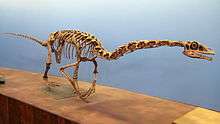Timeline of therizinosaur research
This timeline of therizinosaur research is a chronological listing of events in the history of paleontology focused on the therizinosaurs, unusually long-necked, pot-bellied, and large-clawed herbivorous theropod dinosaurs closely related to birds. The early history of therizinosaur research occurred in three phases. The first phase was the discovery of scanty and puzzling fossils in Asia by the Central Asiatic Expeditions of the 1920s and Soviet-backed research in the 1950s. This phase resulted in the discovery of the Therizinosaurus cheloniformis type specimen. Soviet paleontologist Evgeny Maleev interpreted these unusual remains as belonging to some kind of gigantic turtle.[1]
.jpg)
The second major phase of therizinosaur research followed the discovery of better preserved remains in the 1970s by collaborative research between the Soviets and Mongolians. These finds revealed the true nature of therizinosaurs as bizarre dinosaurs.[1] However, the exact nature and classification of therizinosaurs within Dinosauria was controversial as was their paleobiology. When Rozhdestventsky first reinterpreted therizinosaurs as dinosaurs he argued that they were unusual theropods that may have used their clawed arms to break open termite mounds or collect fruit.[2] Osmolska and Roniewicz also considered therizinosaurs to be theropods.[1]
In 1979, Altangerel Perle named the new species Segnosaurus galbinensis, which although he recognized was an unusual theropod, he did not recognize as a therizinosaur. Consequently, he named the new family Segnosauridae and, in 1980, Segnosauria.[1] Two years later, Perle recognized commonalities between Therizinosaurus and segnosaurs, reclassifying the former as a member of the latter. From hereout therizinosaur research was considered "segnosaur" research.[3] Perle himself thought that his "segnosaurs" were semi-aquatic fish-eaters. However, in the early 1990s, researchers like Rinchen Barsbold and Teresa Maryańska cast doubt on the connection between therizinosaurs and segnosaurs altogether.[3]
Nevertheless, the description Alxasaurus elsitaiensis provided more evidence for a close relationship between the therizinosaurs and "segnosaurs" and led to a revision of their classification. The discovery of this and other primitive therizinosaurs in China formed the beginnings of the third major wave of therizinosaur research.[1] That same year Russell and Russell reinterpreted therizinosaurs as herbivorous foragers like mammalian chalicotherium.[2] Other significant finds of the 1990s include therizinosaur eggs with embryos preserved inside[4] and the first known therizinosaur with feathers, Beipiaosaurus, which was described from China in 1999.[5]
20th century

1950s
1970s
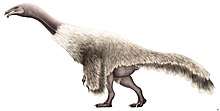
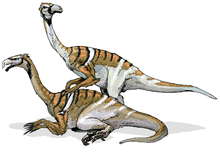
- Rozhdestventsky first proposed the idea that therizinosaurs were actually theropod dinosaurs.[1] He thought they used their large claws to tear open termite mounds or collect fruit from trees.[2]
- Osmolska and Roniewicz also interpreted therizinosaurs as theropod dinosaurs.[1]
- Barsbold proposed the Deinonychosauria and included Therizinosaurus as a member.[1]
- In another 1976 paper, Barsbold referred a shoulder and forearm found in the same strata as the Therizinosaurus type specimen to that genus because of the resemblance between the specimens' claws.[1] He observed that the anatomy of the arm and shoulder remains suggested that it belonged to a theropod dinosaur. Barsbold also remarked on similarities it shared with Deinocheirus, another mysterious dinosaur from the same rock unit.[7]
- Dong described the new genus and species Nanshiungosaurus brevispinus based on a vertebral column and pelvis.[6] He interpreted Nanshiungosaurus as a new kind of sauropod.[1]
- Dong described the new species Chilantaisaurus zheziangensis.[6] He interpreted Chilantaisaurus as a carnosaur.[1]
- Perle described the new genus and species Segnosaurus galbinensis[6] based on mostly complete limbs and girdles. He erected a new family, the Segnosauridae, for this unusual dinosaur. He tentatively regarded it as a theropod.[1]
1980s

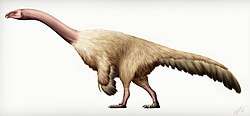
- Barsbold and Perle named the Segnosauria.[6] They thought segnosaurs were semi-aquatic fish-eaters.[2]
- Perle described the new genus and species Erlikosaurus andrewsi.[6] The type specimen of E. andrewsi consisted of a skull, vertebrae, humerus, and foot serendipitously discovered preserved under the remains of another dinosaur that had been excavated from Bayanshiree.[1]
- Perle reported an unusual partial four-toed hind limb from Hermiin Tsav. Because this partial leg was found not far from where Barsbold reported the shoulder and humerus he referred to Therizinosaurus, Perle thought that his specimen also probably belonged to that taxon. Since this leg was similar to those of segnosaurs, he classified Therizinosaurus as a segnosaur.[3]
- Barsbold and Perle described the new genus and species Enigmosaurus mongoliensis based on a partial pelvis.[6] The researchers regarded Enigmosaurus as so unusual that they gave it its own family, the Enigmosauridae.[1]
- Paul suggested that segnosaurs shared an evolutionary relationship with prosauropods and ornithischians.[5] He thought this implied that they were probably herbivores.[2]
- Gauthier considered segnosaurs to be relatives of sauropodomorphs.[5]
- Sereno also considered segnosaurs to be relatives of sauropodomorphs.[5]
1990s

- Barsbold and Maryanska first reinterpreted the "sauropod" Nanshiungosaurus and the "carnosaur" Chilantaisaurus as therizinosaurs.[1] They agreed with Perle that the partial hind limb from Hermiin Tsav he described in 1982 was segnosaurian, but disagreed with his referral of it to Therizinosaurus, and therefore with his subsequent conclusion that Therizinosaurus was a segnosaur. Barsbold and Maryanska also disagreed with previous researchers who classified Deinocheirus as a segnosaur.[3]
- Norman considered Therizinosaurus to be a theropod of uncertain classification.[3]
- Dong named the Segnosaurischia.[6]
- A collaborative expedition between Chinese and Japanese scientists discovered the type specimen of the new species that would later be named Nanshiungosaurus bohlini.[1]

- Russel and Dong described the new genus and species Alxasaurus elsitaiensis.[6] They considered it distinct enough to warrant its own family, the Alxasauridae.[1] They pointed out similar anatomical traits in the anatomy of the hand of the partial forlimb Barsbold referred to Therizinosaurus in 1976 and those of segnosaurs. They concluded that the "segnosaurs" and "therizinosaurs" were actually close relatives. They synonymized the Therizinosauridae and Segnosauridae, with the former having nomenclatural priority. The relative completeness of this taxon's type specimen concluded the debate on whether or not therizinosaurs were theropods in the affirmative.[5]
- Russell and Russell noticed that therizinosaurs had similar body plans to chalicotheres and ground sloths and concluded that they may have used their large forelimbs to forage in a similar manner.[2]
- Clark and others redescribed the skull of Erlikosaurus. They found more evidence that therizinosaurs were theropods.[5]
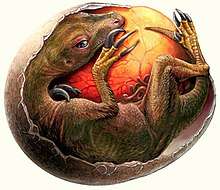
- Nessov speculated that therizinosaurs may have hung from trees using their large claws like sloths do and fed on wasp nests.[2] He reported the discovery of therizinosaur remains in Kazakhstan and Uzbekistan.[8]
- Currie attributed some Late Cretaceous eggs and their embryos from the Nanchao Formation of Henan, China to therizinosaurs. These spherical eggs still preserve the fossilized remains of their developing embryos.[4]
- In a second 1996 paper, Currie attributed another kind of fossil egg from an entirely different oofamily to therizinosaurs. Unlike the spherical eggs of his first paper, these huge "elongated" eggs are classified as members of the Elongatoolithidae and could reach lengths of up to 50 cm.[4]
- Manning and others did not confirm Currie's referral of elongatoolithid eggs to therizinoasaurs.[4]
- Dong and Yu described the new species Nanshiungosaurus bohlini[6] discovered during the 1992 Sino-Japanese expedition.[1]
- Wolfe and Kirkland accidentally refer therizinosaur fossils to the ceratopsian Zuniceratops christoferi.[1]

- Zhao and Zu reported the existence of a possible therizinosaur dentary dating all the way back to the Early Jurassic.[5]
- Xu, Tang, and Wang described the new genus and species Beipiaosaurus inexpectus.[6] The type specimen actually preserves impressions of the animal's feathered integument.[5] It was also the oldest known therizinosaur.[2]
- Carpenter reported that the embryos Currie considered therizinosaurian had teeth in their premaxillae, unlike any known member of the group. This could be evidence that the egglayer was actually primitive for a therizinosaur. He also did not confirm Currie's referral of elongatoolithid eggs to therizinoasaurs.[4]
21st century
2000s

- Manning and others observed that the embryos identified by Currie in 1996 as therizinosaurian had "an unusual pattern of tooth replacement ... in which a slender, elongate tooth is replaced by a symmetrical, denticulate tooth". Contrary to Carpenter's claim in 1999, Manning and his colleagues reported the embryos' premaxillae as toothless.[4]
- Xu, Zhao, and Clark described the new genus and species Eshanosaurus deguchiianus based on a dentary.[6] As of 2004, this species was the probably oldest known therizinosaur, likely dating back to the Hettangian age.[2]
- Kirkland and Wolfe described the new genus and species Nothronychus mckinleyi.[6] This was the first definitive therizinosaur discovered outside of Asia.[1]
- Zhang and others described the new genus and species Neimongosaurus yangi.[6]
- Xu and others described the new genus and species Erliansaurus bellamanus.[6]
- Kirkland and others described the new genus and species Falcarius utahensis.[9]
- Li and others described the new genus and species Suzhousaurus megatherioides.[10]
2010s
- P. Senter, J. I. Kirkland, and D. D. Deblieux described the new genus and species Martharaptor greenriverensis.[11]
- Pu and others described the new genus and species Jianchangosaurus yixianensis.[12]
- Yao and others described the new genus and species Lingyuanosaurus sihedangensis.[13]
- Histological analysis of the forelimb bones of Daliansaurus liaoningensis is presented by Shen et al. (2019).[14]
- A study on the anatomy of the skull of Beipiaosaurus inexpectus is published by Liao & Xu (2019).[15]
Footnotes
- Clark, Maryanska, and Barsbold (2004); "Systematics and Evolution", page 160.
- Clark, Maryanska, and Barsbold (2004); "Stratigraphy, Paleoecology, and Biogeography", page 163.
- Clark, Maryanska, and Barsbold (2004); "Systematics and Evolution", page 161.
- Clark, Maryanska, and Barsbold (2004); "Eggs", page 159.
- Clark, Maryanska, and Barsbold (2004); "Introduction", page 151.
- Clark, Maryanska, and Barsbold (2004); "Table 7.1: Therizinosauroidea", page 152.
- Clark, Maryanska, and Barsbold (2004); "Systematics and Evolution", pages 160–161.
- Clark, Maryanska, and Barsbold (2004); "Stratigraphy, Paleoecology, and Biogeography", page 164.
- Kirkland et al. (2005); "Abstract", page 84.
- Li et al. (2007); "Abstract", page 539.
- Senter, Kirkland and Deblieux (2012); "Abstract", page 1.
- Pu et al. (2013); "Abstract", page 1.
- Xi Yao; Chun-Chi Liao; Corwin Sullivan; Xing Xu (2019). "A new transitional therizinosaurian theropod from the Early Cretaceous Jehol Biota of China". Scientific Reports. 9: Article number 5026. doi:10.1038/s41598-019-41560-z. PMC 6430829. PMID 30903000.
- Caizhi Shen; Junchang Lü; Chunling Gao; Masato Hoshino; Kentaro Uesugi; Martin Kundrát (2019). "Forearm bone histology of the small theropod Daliansaurus liaoningensis (Paraves: Troodontidae) from the Yixian Formation, Liaoning, China". Historical Biology: An International Journal of Paleobiology. 31 (2): 253–261. doi:10.1080/08912963.2017.1360296.
- Chun-Chi Liao; Xing Xu (2019). "Cranial osteology of Beipiaosaurus inexpectus (Theropoda: Therizinosauria)". Vertebrata PalAsiatica. 57 (2): 117–132. doi:10.19615/j.cnki.1000-3118.190115.
References
- Clark, J. M.; Maryanska, T.; Barsbold, Rinchen (2004). "Therizinosauroidea". In Weishampel, D. B.; Dodson, P.; Osmolska, H. (eds.). The Dinosauria (2 ed.). Berkeley: University of California Press. pp. 151–164. ISBN 978-0520254084.
- Kirkland, J. I.; Zanno, L. E.; Sampson, S. D.; Clark, J. M.; DeBlieux, D. D. (2005). "A primitive therizinosauroid dinosaur from the Early Cretaceous of Utah". Nature. 435: 84–87. doi:10.1038/nature03468. PMID 15875020.
- Li D.; Peng C.; You H.; Lamanna, M.C.; Harris, J.D.; Lacovara, K.J.; Zhang J. (2007). "A large therizinosauroid (Dinosauria: Theropoda) from the Early Cretaceous of northwestern China". Acta Geologica Sinica (English edition). 81 (4): 539–549. doi:10.1111/j.1755-6724.2007.tb00977.x.
- Pu, H.; Kobayashi, Y.; Lü, J.; Xu, L.; Wu, Y.; Chang, H.; Zhang, J.; Jia, S. (2013). Claessens, Leon (ed.). "An Unusual Basal Therizinosaur Dinosaur with an Ornithischian Dental Arrangement from Northeastern China". PLoS ONE. 8 (5): e63423. doi:10.1371/journal.pone.0063423. PMC 3667168. PMID 23734177.
- Senter, P.; Kirkland, J. I.; Deblieux, D. D. (2012). Dodson, Peter (ed.). "Martharaptor greenriverensis, a New Theropod Dinosaur from the Lower Cretaceous of Utah". PLoS ONE. 7 (8): e43911. doi:10.1371/journal.pone.0043911. PMC 3430620. PMID 22952806.
External links
![]()
